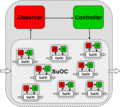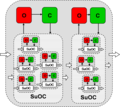Organic Computing
Organic Computing describes an interdisciplinary research initiative with the explanatory concern of gaining a better understanding of organic structures and the development goal of organically structured information technology. The research initiative refers to the biological paradigm of self-organized information processing in organic systems. Biological organisms show specific phenomenal characteristics, so-called self-x characteristics , which are cited as quality characteristics of an organically structured information technology. The realization of the desired quality features should be based on the concept of self-organization . This fundamental methodological positioning implies in particular a departure from algorithmically organized information technology.
Among other things - motivated by the challenges for IT with regard to the design of technical systems, which will be present from around 2015 - answers to the problems of the expected technological developments will be worked out. The advancing miniaturization and the increase in the performance of micro- and nanoelectronic systems mean that in the future there will be a large number of intelligent systems that provide their services in dynamically changing operational environments. Information is exchanged with one another via a wide variety of communication systems, and networks of intelligent systems inevitably arise whose behavior cannot be fully predicted. The individual components must therefore be able to react sensibly even in unforeseen situations, i.e. H. Technical systems will and must be able to coordinate their behavior with one another and with the environment - they adapt and they organize themselves.
Self-x properties
Self-organization does not in itself constitute a quality feature because a self-organized system configuration does not necessarily correspond to the technical objective. Uncontrolled self-organization processes can sometimes have completely dramatic consequences. Self-organized systems should therefore remain manageable. They should not develop any behavior that runs counter to the desired functionality and the current requirements, especially of human users. The question regarding the technology of the future is therefore not whether self-organized systems will emerge, but how we will shape them.
What is needed are systems that can adapt to different operating conditions and functional requirements through a sufficient number of degrees of freedom, compensate for the incorrect behavior of components by taking appropriate measures, taking into account the needs of human users in particular and, overall, providing reliable support to people in their living conditions in a variety of ways. System architectures are required which are particularly characterized by robustness and flexibility. Because of the life-like behavior of such systems, they are called organic. The future organic computer science systems should have a number of so-called self-x properties, they are in particular
- self-configuring,
- self-optimizing,
- self healing,
- self protective and
- self explanatory.
After the vision of organic computing was presented in a position paper by the GI and ITG / VDE, the establishment of the DFG priority program 1183 Organic Computing gave this new research direction a major boost. In currently 18 research projects, the properties of self-organizing systems will be fundamentally investigated by 2011, suitable system architectures will be designed and tools developed that support the design and management of these systems in a variety of ways.
The field of organic computing has strong links to the Autonomic Computing Initiative from IBM, which, however, focuses on mastering the complexity of large server architectures by generating self-x properties. Organic Computing, however, pays particular attention to the behavior of the overall system resulting from local interaction, in which unforeseen global effects can occur. Since not every self-organizing (also called emergent) behavior is desired, Organic Computing strives for a form of controlled self-organization, such as is achieved through the generic observer / controller architecture.
Observer / controller architecture
In the area of organic, autonomous and autonomously-related systems, there are a number of other architectural approaches to support self-organizing, adaptive behavior in addition to the observer / controller architecture . To be mentioned here in particular
- the MAPE cycle, which describes the essential work steps of an Autonomic Element with Monitor, Analyze, Plan and Execute and is therefore a central concept of Autonomic Computing,
- the operator / controller modules developed by the DFG Collaborative Research Center 614, which are mainly used in self-optimizing mechanical engineering systems,
- the Organic Control Units (OCU) designed as part of the Organic Fault-Tolerant Control Architecture for Robotic Applications project, which enable the self-organized behavior of 6-legged walking robots,
- the SPA architecture (Sense, Plan and Act) from robotics or the 3-level architecture (component control, change management and goal management) from software engineering for adaptive systems,
- agent-based approaches, such as those used in robot soccer (e.g.) or in self-organizing factories (e.g.), and
- autonomous system-on-chip architectures (e.g.).
In the observer / controller architecture, the essential components of these architectural approaches are combined into a generic concept in which the aspects of machine learning are also taken into account.
- Different observer / controller architectures
The observer / controller architecture observes, analyzes and evaluates the behavior of the systems to be monitored with regard to specified target criteria in a kind of control loop . This leads to the selection of suitable measures to influence future behavior in the desired direction. The architecture consists of a network of autonomous units (called productive system), supplemented by one or more observer and controller units. An appropriate methodology must be developed for the observer to observe the (global) system behavior and to analyze and evaluate the occurrence of emergence effects. A method for quantifying emergence based on Shannon's entropy definition is proposed in. Based on the results of the observer, the controller should decide in which form the productive system must be influenced in order to enable controlled, self-organized global behavior within the limits and goals that are specified by an external unit (the environment). The controller should thus be able to improve its behavior by learning, i. H. adapting behavior, especially based on experience with the effects of previous actions. For more information on the generic framework, please refer to.
Robustness and flexibility
In addition to the quantification and controllability of emergent behavior, the requirement for robustness and adaptivity of an organic system is one of the main challenges: How must a system be designed so that its functionality can adapt to changes in the operational environment and at the same time react robustly, i.e. H. its functionality is still fulfilled despite changes in the environmental parameters? How can system properties such as robustness, flexibility, autonomy and self-organization be quantified? Approaches for a more quantitative consideration can be found in, among others
There is still a long way to go before the system requirements formulated in the vision of organic computing can be realized. However, important concepts have already been developed and partial results have been achieved in the DFG priority program 1183 Organic Computing. It is important to supplement this basic research program with further, more application-oriented research projects in order to test and further develop the theoretical and methodological knowledge gained in the priority program in specific technical systems.
Current research
First steps towards organic, self-organizing and adaptive systems are being undertaken in the DFG priority program 1183 Organic Computing. In doing so, a large number of questions are considered, which, in addition to other aspects, include the following focal points: adaptivity, reconfigurability, emergence of new system properties and self-organization in technical systems.
literature
- Würtz, Rolf P. (Editor): Organic Computing (Understanding Complex Systems) . Springer , 2008. ISBN 978-3642096426 .
- Sinsel, Alexander: Organic Computing (as a concept for controlling interacting processes in distributed systems) . Optimus Wissenschaftsverlag, Göttingen , March 2011. ISBN 978-3941274679 .
- Christian Müller-Schloer, Hartmut Schmeck, Theo Ungerer (Editor): Organic Computing - A Paradigm Shift for Complex Systems . Springer , 2011. ISBN 978-3-0348-0129-4
Web links
- Organic Computing Initiative
- VDE / ITG / GI position paper Organic Computing (PDF; 140 kB)
- DFG Priority Program 1183 Organic Computing
- FAQ on self-organizing systems (English)
Individual evidence
- ↑ Chapter 2.1 (PDF; 377 kB) from Sinsel, Alexander: Organic Computing (as a concept for controlling interacting processes in distributed systems) . Optimus Wissenschaftsverlag, Göttingen, March 2011. ISBN 978-3941274679 .
- ↑ Von der Malsburg, Christoph: The Challenge of Organic Computing. Memorandum, 1999 ( Memento of the original dated July 2, 2010 in the Internet Archive ) Info: The archive link was inserted automatically and has not yet been checked. Please check the original and archive link according to the instructions and then remove this notice. (PDF; 38 kB).
- ^ A b DFG priority program 1183 Organic Computing
- ↑ H. Schmeck. Organic Computing. Artificial Intelligence, 3: 68-69, 2005.
- ↑ C. Müller-Schloer, C. von der Malsburg and RP Würtz. Organic Computing, current catchphrase in computer science spectrum, pages 332–336, 2004.
- ↑ C. Müller-Schloer. Organic Computing - On the Feasibility of Controlled Emergence. In Proceedings of the 2nd IEEE / ACM / IFIP International Conference on Hardware / Software Codesign and System Synthesis (CODES + ISSS 2004), pages 2-5. ACM Press, 2004.
- ↑ H. Schmeck. Organic Computing - A new vision for distributed embedded systems. In Proceedings of the 8th IEEE International Symposium on Object-Oriented Real-Time Distributed Computing (ISORC 2005), pages 201-203. IEEE Computer Society, 2005.
- ↑ Position paper from GI and ITG / VDE (PDF; 140 kB)
- ↑ a b J. O. Kephart and DM Chess. The vision of autonomic computing. IEEE Computer, 1, pp. 41-50, 2003.
- ↑ a b U. Richter, M. Mnif, J. Branke, C. Müller-Schloer and H. Schmeck. Towards a generic observer / controller architecture for Organic Computing. In C. Hochberger and R. Liskowsky, editors, INFORMATIK 2006 - Informatik für Menschen !, volume P-93 of GI-Edition - Lecture Notes in Informatics (LNI), pages 112–119. Köllen Verlag, 2006.
- ↑ O. Oberschelp, T. Hestermeyer, B. Kleinjohann and L. Kleinjohann. Design of self-optimizing agent-based controllers. In CfP Workshop 2002 - Agent-Based Simulation 3, 2002.
- ↑ F. Mösch, M. Litza, A. El Sayed Auf, E. Maehle, KE Großpietsch and W. Brockmann. ORCA - Towards an Organic Robotic Control Architecture. In H. De Meer and JPG Sterbenz, editors, Proceedings of the 1st International Workshop on Self-Organizing Systems (IWSOS 2006), volume 4124 of Lecture Notes in Computer Science, pages 251-253, Berlin / Heidelberg, Germany, September 2006. Jumper.
- ↑ S. Dobson, S. Denazis, Fernndez, Antonio, D. Gati, E. Gelenbe, Massacci, P. Nixon, F. Saffre, N. Schmidt and F. Zambonelli. A survey of autonomic communications. ACM Trans. Auton. Adapt. Syst., 1, pp. 223-259. 2006.
- ↑ E. Gat. Three-layer architectures. Artificial Intelligence and Mobile Robots, MIT / AAAI Press, 1997.
- ↑ M. Riedmiller, T. Gabel, R. Hafner, S. Lange and M. Lauer. The Brainstormers: Design principles of self-learning autonomous robots. Informatik-Spektrum, 29 (3): 175-190, 2006.
- ^ H. Van Dyke Parunak. What can agents do in industry, and why? In Cooperative information agents: 2nd International workshop, 1998.
- ↑ A. Bouajila, J. Zeppenfeld, W. Stechele, A. Herkersdorf, A. Bernauer, O. Bringmann and W. Rosenstiel. Organic computing at the system on chip level. In Proceedings of the IFIP International Conference on Very Large Scale Integration of System on Chip (VLSI-SoC 2006), 2006.
- ↑ M. Mnif and C. Müller-Schloer. Quantitative Emergence. In Proceedings of the 2006 IEEE Mountain Workshop on Adaptive and Learning Systems (IEEE SMCals 2006), pages 78-84, 2006.
- ↑ C. Müller-Schloer and B. Sick. Emergence in Organic Computing Systems: Discussion of a Controversial Concept. In Proceedings of 3rd International Conference on Autonomic and Trusted Computing (ATC 2006), volume 4158 of Lecture Notes in Computer Science, pages 1-16, 2006. Springer.
- ↑ E. Cakar, M. Mnif, C. Müller-Schloer, U. Richter and H. Schmeck. Towards a quantitative notion of self-organization. In Proceedings of the 2007 IEEE Congress on Evolutionary Computation (CEC 2007), pages 4222-4229, 2007.



